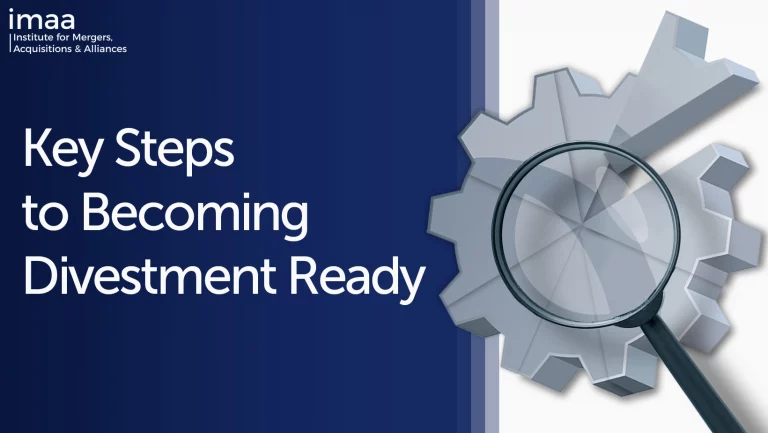
Blog Key Steps to Becoming Divestment Ready
- Blog
Key Steps to Becoming Divestment Ready
- Tom Allen

SHARE:
Many companies excel in the acquisition process, equipped with the necessary skills and capabilities. However, when it comes to divesting, many have not experienced the process. This is compounded by the fact that divesting a business can often be more challenging than acquiring one. Successfully managing a divestment, much like an acquisition, demands an experience-driven skill set and extensive preparation to become divestment-ready. A prepared seller needs to identify potential problems early and take proactive steps to minimise disruption to employees, shareholders, and other stakeholders. According to EY, 41% of surveyed companies reported that a lack of preparation negatively impacted the value of their divestment, and 51% indicated that the divestiture process took significantly longer than the anticipated three-month timeline.
Getting Divestment Ready
Preparing for divestment goes far beyond simply identifying potential buyers. To become divestment-ready, a company must:
- Conduct a strategic analysis of the business unit targeted for divestment.
- Critically assess the underlying drivers of the potential divestment and understand any possible adverse implications.
- Gain a thorough understanding of the overall M&A market landscape (e.g., determining whether it is a buyer’s or seller’s market and analysing trends in deal multiples).
- Undertake a valuation exercise and consider a range of possible outcomes.
- Research potential buyers and evaluate the merits of strategic versus financial buyers (and vice versa).
- Establish a dedicated divestment and separation team.
- Ensure the completeness and accuracy of all information required for buyer due diligence (e.g., financial statements and contracts).
- Develop methods to minimise disruption to everyday business activities throughout the divestment process, including the separation phase.
Becoming divestment-ready cannot be accomplished in just two to three months. A successful divestment process should begin 12-18 months before the start of the divestment sales cycle (i.e., going live to market). This extensive planning is essential to ensure the divestment team remains in control, setting the pace and direction of the divestment process. A word of caution: reacting to an unsolicited or off-market approach from a seemingly interested potential acquirer and making a knee-jerk decision to enter into a sales process is usually the worst course of action.
Ultimately, the more prepared you are, the greater your ability to control the outcome of the divestment.
The Importance of Sell-Side Divestment-Ready Planning
In essence, sell-side divestment planning involves the review, analysis, decision-making and actions necessary for a successful divestment. This planning should align with long-term corporate goals and have strategic intent at its core.
To establish early-stage divestment priorities, consider these key questions:
- Why are we considering a divestment? Identify the reasons driving the divestment, such as declining revenue, lack of strategic fit with corporate objectives, the need to raise capital, service debt, refinance, etc. (or reacting to an unsolicited offer).
- How should we divest? This decision should align with corporate goals and timelines and will likely influence the pool of potential buyers targeted (e.g., outright 100% sale, partial sale, equity carve-out, etc.).
- Who wants to acquire? Understanding potential buyers will aid in marketing the business unit for sale and is likely to impact the purchase terms.
- What makes the business unit saleable? Determine what makes the business unit attractive and why it might be more valuable under different ownership.
Bain & Co outline that 53% of senior executives report that having a clear strategic rationale for the divestment is behind divestment success. This emphasizes why being divestment-ready requires a 12–18-month window. Success doesn’t happen overnight, but failure certainly can.
Identify the Rationale for Divestment
Careful consideration should be given to the rationale behind a divestment, as it helps frame the narrative presented to shareholders, employees, other stakeholders, and – perhaps most importantly – potential buyers.
- While not an exhaustive list, the most common drivers of divestment activity include:
- Refocus on core competencies: To stay competitive in its primary service or product offering, a company may need to refocus on its core competencies, which is a significant driver of divestment activity today.
- Raise capital: Divesting a business unit generates capital that can be redeployed to areas with higher returns, such as corporate venture (CVC) activity, new acquisitions, or paying down debt/refinancing.
- Unlock value: A business unit might perform significantly better under the ownership of another company whose core competencies align with those of the divested unit.
- Meet anti-trust requirements: Government regulators, under anti-trust laws, may require a company in an uncompetitive industry to divest or separate a business unit to proceed with an M&A transaction that would otherwise limit competition. Faced with this decision, the selling company must choose whether to divest or forgo the proposed acquisition.
Building Sell-side Capabilities
A continuous focus on the portfolio management of business units and a cadence of regular, small divestments is typically less disruptive than a blockbuster “mega divestment” – or divesting of multiple business units at once – due to the risk this brings, and the disruption caused to the ordinary course of business. Focusing on core business units allows a company to communicate a clear and compelling growth story. Conversely, selling “when you have to” is too late and might be interpreted as a sign of distress in the market. On this point, Harvard Business Review outlines that taking this approach is central to building internal sell-side capabilities.
A portfolio management-led approach to evaluating business units as potential divestment candidates can be supported by establishing a dedicated sell-side team (either with or without support from external advisors) to become divestment-ready. The remit of this team should be to continually/periodically review business units and identify those that could be deemed as suitable divestment candidates. EY reports that 63% of companies hold onto business assets for too long (rather than divesting) – so taking approach can prevent a business unit becoming orphaned or being held for longer than it should.
There’s a myriad of assessment criteria to consider when it comes to evaluating a business unit for divestment – some examples are outlined below.
Strategic Alignment
- Does the business unit align with the company’s current strategy, long-term vision, and mission statement?
- What are the core value drivers of the business unit?
- How does the business unit affect other parts of the company?
- How would divesting influence the company’s overall supply chain?
- What is the calibre of the management team, and how might a prospective buyer view this?
Financial Contribution
- What are the short, medium, and long-term financial projections?
- Is the demand for products or services on the rise or in decline?
- How does the P&L contribute to overall financial health?
- Is the business unit depleting cash or consuming resources at an unsustainable pace?
- Are profit margins expanding or shrinking?
- Are there any emerging markets that could support long-term financial growth?
Competitive Landscape
- Does the business unit have a well-defined market position?
- What products and services are offered by competitors?
- What are the main benefits and features of competitors’ products and services?
- Is the primary industry dominated by a few competitors (concentrated), or is it fragmented and prone to consolidation?
- Where are the gaps in the current product or service offerings?
- Do any competitors possess a distinct and sustainable advantage?
- Is there a leading player in mergers and acquisitions (M&A)?
Assets
- What intellectual property, proprietary products and services or skills (people) does the business unit possess? How attractive would these be to a prospective acquirer and could they help the business unit command a premium valuation on sale?
- What patents have competitors been able to secure and do these curtail operations of the business unit (freedom to operate).
Customer Base
- Is the customer base attractive? Consider key customers and logos.
- Is the customer base stable? Consider churn on a monthly/annual basis and compare to industry norms.
- Are there untapped opportunities for cross-selling with other areas of the company?
- Would divestment disadvantage the company when it comes to retaining or growing its customer base?
Risk & Compliance
- Are there any critical operating risks to consider?
- Is the business unit compliant with internal policies and any relevant external regulations?
- Is the business unit operating in a highly regulated marketplace?
- Could anti-trust/laws/competition policy impact divestment activity?
Considering the Impact of Divesting
- Would the business unit be more valuable to another owner?
- Is the estimated value of the business unit likely to generate a significant cash in-flow?
- What are the tax implications of divesting? Could a chargeable gain crystalize?
- Would the company experience unabsorbed overhead costs, reduced capabilities and loss of inter-divisional sales as a result of divesting of the business unit?
- How will the divestment be interpreted by the market (consider framing a “divestment story”).
Conduct a Divestment Readiness Assessment
A divestment readiness assessment can be completed internally via a survey, workshop, or a combination of these. An assessment can also be undertaken by outside experts via interviews and standard data collection methods to judge divestment-readiness. These methods include employee and manager interviews and surveys. When collecting data from a large number of employees, focus groups can also be used in place of one-on-one interviews.
Information collected from the readiness assessment can help shape a divestment strategy. This includes:
- The most appropriate governance model to oversee the divestment;
- The key people to manage the divestment and expected resource requirements;
- The most appropriate executive sponsorship model and support;
- Critical timelines and milestones;
- The principal risks and how these can be best mitigated;
- External consulting and support requirements (e.g. tax, accounting, financial).
Takeaway
- Preparing for divestment is a lengthy process that involves more than just finding potential buyers. Aim to plan 12-18 months ahead before entering the market.
- Make sure you fully understand the reasons behind the divestment and consider how to present the divestment story (the narrative around selling a business unit).
- Adopt a portfolio management strategy for business units and develop sell-side expertise by forming a dedicated divestment and separation team.
- Evaluate a wide range of criteria when identifying business units as possible divestment candidates.
- Conduct a divestment readiness assessment to inform and shape your divestment strategy.
TAGS:


Stay up to date with M&A news!
Subscribe to our newsletter


